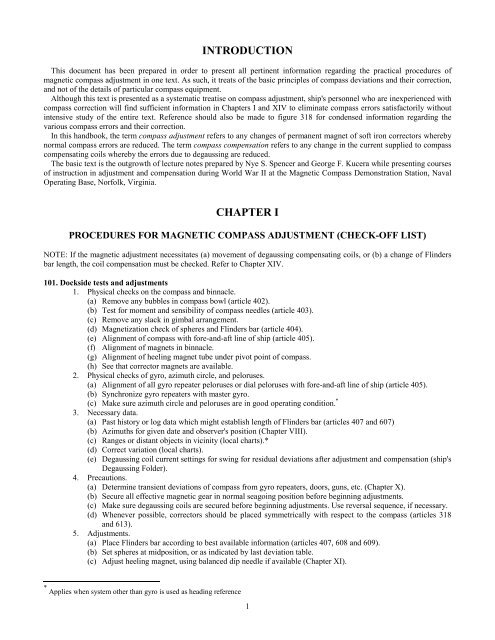Handbook of Magnetic Compass Adjustment - Maritime Safety ...
Handbook of Magnetic Compass Adjustment - Maritime Safety ...
Handbook of Magnetic Compass Adjustment - Maritime Safety ...
You also want an ePaper? Increase the reach of your titles
YUMPU automatically turns print PDFs into web optimized ePapers that Google loves.
INTRODUCTION<br />
This document has been prepared in order to present all pertinent information regarding the practical procedures <strong>of</strong><br />
magnetic compass adjustment in one text. As such, it treats <strong>of</strong> the basic principles <strong>of</strong> compass deviations and their correction,<br />
and not <strong>of</strong> the details <strong>of</strong> particular compass equipment.<br />
Although this text is presented as a systematic treatise on compass adjustment, ship's personnel who are inexperienced with<br />
compass correction will find sufficient information in Chapters I and XIV to eliminate compass errors satisfactorily without<br />
intensive study <strong>of</strong> the entire text. Reference should also be made to figure 318 for condensed information regarding the<br />
various compass errors and their correction.<br />
In this handbook, the term compass adjustment refers to any changes <strong>of</strong> permanent magnet <strong>of</strong> s<strong>of</strong>t iron correctors whereby<br />
normal compass errors are reduced. The term compass compensation refers to any change in the current supplied to compass<br />
compensating coils whereby the errors due to degaussing are reduced.<br />
The basic text is the outgrowth <strong>of</strong> lecture notes prepared by Nye S. Spencer and George F. Kucera while presenting courses<br />
<strong>of</strong> instruction in adjustment and compensation during World War II at the <strong>Magnetic</strong> <strong>Compass</strong> Demonstration Station, Naval<br />
Operating Base, Norfolk, Virginia.<br />
CHAPTER I<br />
PROCEDURES FOR MAGNETIC COMPASS ADJUSTMENT (CHECK-OFF LIST)<br />
NOTE: If the magnetic adjustment necessitates (a) movement <strong>of</strong> degaussing compensating coils, or (b) a change <strong>of</strong> Flinders<br />
bar length, the coil compensation must be checked. Refer to Chapter XIV.<br />
101. Dockside tests and adjustments<br />
1. Physical checks on the compass and binnacle.<br />
(a) Remove any bubbles in compass bowl (article 402).<br />
(b) Test for moment and sensibility <strong>of</strong> compass needles (article 403).<br />
(c) Remove any slack in gimbal arrangement.<br />
(d) Magnetization check <strong>of</strong> spheres and Flinders bar (article 404).<br />
(e) Alignment <strong>of</strong> compass with fore-and-aft line <strong>of</strong> ship (article 405).<br />
(f) Alignment <strong>of</strong> magnets in binnacle.<br />
(g) Alignment <strong>of</strong> heeling magnet tube under pivot point <strong>of</strong> compass.<br />
(h) See that corrector magnets are available.<br />
2. Physical checks <strong>of</strong> gyro, azimuth circle, and peloruses.<br />
(a) Alignment <strong>of</strong> all gyro repeater peloruses or dial peloruses with fore-and-aft line <strong>of</strong> ship (article 405).<br />
(b) Synchronize gyro repeaters with master gyro.<br />
(c) Make sure azimuth circle and peloruses are in good operating condition. *<br />
3. Necessary data.<br />
(a) Past history or log data which might establish length <strong>of</strong> Flinders bar (articles 407 and 607)<br />
(b) Azimuths for given date and observer's position (Chapter VIII).<br />
(c) Ranges or distant objects in vicinity (local charts).*<br />
(d) Correct variation (local charts).<br />
(e) Degaussing coil current settings for swing for residual deviations after adjustment and compensation (ship's<br />
Degaussing Folder).<br />
4. Precautions.<br />
(a) Determine transient deviations <strong>of</strong> compass from gyro repeaters, doors, guns, etc. (Chapter X).<br />
(b) Secure all effective magnetic gear in normal seagoing position before beginning adjustments.<br />
(c) Make sure degaussing coils are secured before beginning adjustments. Use reversal sequence, if necessary.<br />
(d) Whenever possible, correctors should be placed symmetrically with respect to the compass (articles 318<br />
and 613).<br />
5. <strong>Adjustment</strong>s.<br />
(a) Place Flinders bar according to best available information (articles 407, 608 and 609).<br />
(b) Set spheres at midposition, or as indicated by last deviation table.<br />
(c) Adjust heeling magnet, using balanced dip needle if available (Chapter XI).<br />
* Applies when system other than gyro is used as heading reference<br />
1

















